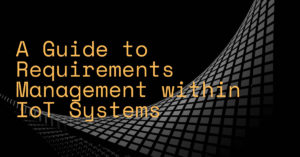Understanding Internet of Things Systems
The Internet of Things (IoT) is the integration of devices, machines, and everyday objects that can gather and share data over the internet. These gadgets, also known as Internet of Things devices, have the potential to increase productivity, promote safety, and provide fresh insights to a variety of enterprises. They range from simple sensors to complex equipment. The concept of IoT has been around for decades, but technological advancements have enabled more and more devices to be connected to the internet, resulting in a rapid expansion of the IoT ecosystem.
Devices, computing systems, networking, and software applications are all components of IoT systems. Sensors, cameras, and actuators are the physical components that collect and transmit data in the Internet of Things. Data is processed and stored by computing systems such as servers and gateways. Connectivity, such as Wi-Fi, Bluetooth, and cellular networks, enables devices and computing systems to connect. For example, mobile apps and internet portals provide a user interface for engaging with data and operating equipment.
IoT has the potential to alter various industries, including healthcare, manufacturing, transportation, and agriculture. IoT can be used in manufacturing to improve production processes and supply chain management. IoT-enabled medical devices can remotely monitor patients and improve treatment efficiency. IoT could be utilized in transportation to improve traffic flow and promote road safety. IoT could be used in agriculture to improve agricultural productivity and animal welfare.
Identifying and Gathering Requirements
The management of requirements is a vital component in developing IoT systems. It comprises identifying, gathering, defining, validating, and maintaining the system’s requirements throughout its existence. The management of requirements ensures that the final product meets the demands of the stakeholders and is fit for its intended purpose.
All stakeholders, including end users, developers, and business owners, must be involved in creating and gathering requirements. Techniques like interviews, surveys, and workshops can be used to acquire information about the stakeholders’ requirements and expectations. Furthermore, a technology like Valispace, a web-based platform for managing requirements, may consolidate and organize requirement while simplifying communication among stakeholders.
After gathering the requirements, it is critical to prioritize them based on their importance and impact on the system. This can be performed through a process known as MoSCoW analysis, which categorizes requirements as must-have, should-have, could-have, and won’t-have. The development team can prioritize the most critical and impactful features by prioritizing the requirements.
Requirements Specification and documentation
When the requirements have been determined and obtained, the following stage is to identify and record them. This requires detailed data about the requirements, such as their attributes, constraints, and acceptance criteria.
Best practices for expressing and documenting requirements include having a clear and consistent structure, providing examples and use cases, and employing diagrams and visuals to aid comprehension. A technology like Valispace, which enables simple change and version control of requirements, may be used to store and maintain the specs.
Assessing how the requirements affect the overall system architecture and design is vital. This can be performed by creating system and domain models, which provide a high-level view of the system and its components.

Validation and verification of requirements
Testing and verifying requirements is a vital stage in developing IoT systems. It requires ensuring that the requirements are detailed, consistent, and testable, as well as meeting the demands of the stakeholders.
Testing, inspections, and reviews are some of the methods that can be used to check and verify requirements. Testing is the process of comparing the system or its components to the requirements. It can include both functional and non-functional testing. Inspections involve a team of professionals conducting a rigorous assessment of the standards and specifications. During reviews, stakeholders and subject matter experts formally assess the requirements and specifications.
A system like Valispace, which allows for traceability between requirements and testing, may be used to ensure that all requirements have been verified and confirmed. Furthermore, Valispace fosters collaboration between the development team and stakeholders, making identifying and resolving difficulties easier.
Managing Requirement Changes
IoT systems are prone to change over time, and it is vital to have a process in place to manage these changes. Various factors, including new business requirements, technological advancements, and legislative changes, could trigger changes.
A solution like Valispace, which provides easy administration of requirement changes, may help to ensure that changes are carried out in a controlled and efficient manner. A change management procedure should be created to ensure that modifications are regulated and recorded and that their impact on the system is understood. A change request and approval mechanism and a method for recording and managing changes should be included in the process.
Requirements for IoT Security and Privacy
Because IoT systems regularly collect and transmit sensitive data, security and privacy are critical considerations. Identifying and managing security and privacy requirements throughout the system’s development is crucial.
Authentication and authorization are significant challenges in protecting IoT devices and systems. Devices should be designed to prevent unauthorized access, and data exchange between devices and servers should be secured. Furthermore, the physical security of the devices and the security of the data held within them must be considered.
It is vital to safeguard personal information and ensure that it is only obtained, maintained, and disseminated with the appropriate authorization. Privacy requirements, such as data collection, storage, and sharing methods, should also be considered. Regulations such as the General Data Protection Regulation (GDPR) should also be considered.
Top Requirements Management Platforms for IoT systems
Valispace:
Valispace is a software tool designed for requirements management in engineering projects. It allows teams to manage and trace requirements, BOMs and interfaces, and also to collaborate on design and testing.
Valispace is the only solution here that links requirements (and components) to technical data and engineering values. Meaning that if requirement parameters change somewhere in the project, you’ll automatically see the effect that this has on the overall system. Speak with our experts and see how Valispace fits in to your engineering workflow today
IBM Rational DOORS:
IBM Rational DOORS is a widely used requirements management tool that offers a range of features such as traceability, impact analysis, and requirements management. It is used by all engineers that need to manage complex, technical projects.
Jama Software:
Jama Software also has capabilities like traceability, collaboration, and impact analysis. It is well suited for engineers that need to manage large, complex projects.
ReqView:
ReqView offers a range of features such as traceability, collaboration, and impact analysis. It is good solution for engineers that need to manage large, complex projects and need to collaborate with remote teams.
ReqView may not be as well suited for projects with a high degree of technical complexity and may not offer all the functionalities as other more complex tools.
Helix RM:
Helix RM offers traceability, collaboration, and impact analysis. It is a good option for all engineering companies and can integrate with other tools such as JIRA, Confluence, and more.
Helix RM may not be suitable for product development with a great deal of technical intricacy, and might not provide all the features that other more complete requirements tools do.
Obstacles for Requirements Management in IoT systems
Developing IoT systems can be complex due to the system’s complexity, the need for real-time processing, and the need to manage vast amounts of data. Furthermore, IoT systems usually involve several stakeholders and necessitate coordination between different teams and domains.
One of the most difficult challenges in IoT systems is the demand for real-time processing, as data gathered by IoT devices are typically time-sensitive. This necessitates using edge computing and fog computing, which may bring computation and storage closer to the devices and reduce latency.
Another area for improvement is managing large amounts of data. This can be addressed by leveraging technology such as big data analytics and machine learning, which can aid in extracting insights from data and converting it into usable information.
Best Practices
Best practices for overcoming these challenges include using a solution like Valispace, which offers easy requirement management and stakeholder collaboration. Furthermore, it is vital to understand the system architecture and design and to incorporate all stakeholders in the development process.
IoT systems can alter many industries and improve efficiency, safety, and understanding of many aspects of our lives. However, developing IoT systems can be complex due to system complexity, the need for real-time processing, and the need to manage massive amounts of data.
The management of requirements is a vital component in developing IoT systems. It comprises identifying, gathering, defining, validating, and maintaining the system’s requirements throughout its existence. If the requirements are properly managed, the final product can meet the demands of the stakeholders and be fit for its intended purpose.
Valispace is an efficient method for managing the requirements of IoT systems. It offers simple requirement editing and version control, requirement centralization and organization, requirement traceability between requirements and testing, the collaboration between the development team and stakeholders, and requirement change management.
Finally, IoT systems have the potential to transform many industries while also increasing efficiency, safety, and insights into many aspects of our lives.
However, developing IoT systems can be complex due to system complexity, the requirement for real-time processing, and the need to manage massive amounts of data.
These barriers can be overcome by employing technologies such as Valispace and best practices for requirements management, allowing IoT to reach its full potential.


